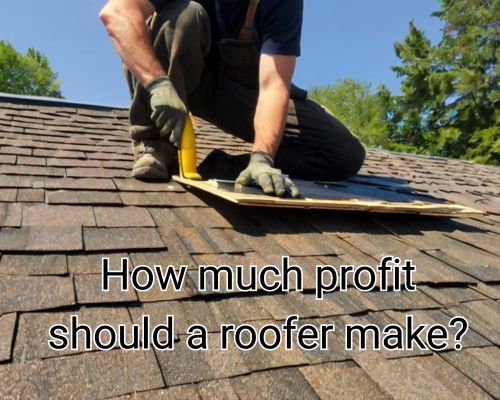In the vibrant roofing market of West Palm Beach, Florida, a common—and crucial—question arises among homeowners, contractors, and aspiring entrepreneurs alike: How much profit should a roofer make? The answer isn’t a flat percentage. It hinges on several variables, including operational costs, local market demand, seasonal trends, labor rates, and even weather. Understanding roofing profitability is essential whether you’re hiring a roofer or thinking about launching a roofing business in South Florida.

With Star Roofing, let’s break down the realistic profit expectations for roofers, highlight key financial benchmarks, and explore how the West Palm Beach roofing market compares to national norms.
Average Roofing Profit Margins: National vs. Local
Nationally, roofing companies typically aim for net profit margins between 5% and 15%, depending on the size of the business and efficiency of operations. However, these figures fluctuate based on regional factors.
In West Palm Beach, profit margins often land on the higher side of that range—closer to 12%–15%, particularly for well-established firms. That’s because:
- There’s year-round demand for roof maintenance and installation due to the subtropical climate.
- Hurricane season increases the need for roof repairs and replacements.
- A growing real estate market spurs ongoing construction and remodeling work.
Salient entities such as labor costs, insurance, materials, and overhead expenses all play into the final profit calculation.
Breaking Down Roofer Business Expenses
To understand profit, we must first understand what eats into it. A typical roofing job in Palm Beach County includes:
- Material Costs (40%-50%)
Roofing materials such as asphalt shingles, clay tiles, or metal roofing can consume up to half the project budget. In Florida, metal roofs and tile roofing are increasingly common due to their wind resistance and energy efficiency. - Labor Costs (25%-35%)
Skilled labor is in high demand. In West Palm Beach, the average hourly wage for roofers is around $22 to $30, depending on experience, according to the U.S. Bureau of Labor Statistics. - General Overhead (10%-15%)
This includes office rent, vehicle fuel and maintenance, software, licensing, and staff salaries. Notably, roofing contractors in South Florida must also carry General Liability Insurance and Workers’ Compensation, which can be higher due to hurricane risk. - Marketing and Lead Generation (5%-8%)
Local roofers often invest in SEO, Google Ads, and social media marketing to stay visible in a saturated market. Targeting keywords like “roof replacement West Palm Beach” or “roof repair near me” can drive valuable leads.
Only after all these costs are covered does net profit enter the conversation. For more, visit Star Roofing.
What Should a Roofer Actually Profit Per Job?
A typical roof replacement project in West Palm Beach for a 2,000 sq ft home ranges from $12,000 to $20,000, depending on roofing type and complexity.
Let’s run a simplified example:
- Total Job Price: $16,000
- Material Costs: $7,000
- Labor Costs: $4,500
- Overhead: $2,000
- Marketing/Lead Costs: $800
- Total Expenses: $14,300
- Net Profit: $1,700
- Profit Margin: 10.6%
That’s a healthy and realistic margin for an efficiently run roofing company in West Palm Beach.
Factors That Impact Roofing Profitability in South Florida
1. Weather & Climate Volatility
Hurricane threats increase demand but also liability and insurance premiums. Roofers often charge more during peak storm season, but they also absorb more risk.
2. Permitting & Code Compliance
Palm Beach County requires roofing permits, inspections, and compliance with Florida Building Code (FBC) standards. Navigating this bureaucratic landscape adds administrative overhead but also acts as a barrier to entry—benefiting seasoned pros.
3. Competition & Market Saturation
The West Palm Beach roofing market is competitive. Profit margins can shrink for smaller operations trying to underbid. However, those offering specialized services—such as solar-ready roofs or cool roof coatings—may charge a premium.
Key Metrics Roofing Contractors Use to Measure Profitability
Beyond gross and net margins, top roofing companies in Florida monitor:
- Job Cost Variance (JCV) – The difference between estimated and actual costs
- Average Job Profit (AJP) – Net profit per job over time
- Closing Rate – Number of quotes turned into signed contracts
- Customer Lifetime Value (CLV) – Repeat business potential through maintenance plans
These allow roofers to spot inefficiencies, negotiate better material prices, or improve labor utilization.
Roofing Company Size and Its Impact on Profit
- Small, Independent Roofers (1–3 crews)
Typically operate on thinner margins—5%–8%, often due to fewer bulk material discounts and less brand visibility. - Mid-size Contractors (3–10 crews)
Benefit from economies of scale, more consistent scheduling, and higher visibility. Profit margins can rise to 10%–15% with the right systems. - Franchise or Enterprise-Level Operations
Might report higher gross revenue, but their operational overhead can offset margins unless exceptionally streamlined.
The Local West Palm Beach Edge
Roofers in West Palm Beach have distinct advantages:
- High demand due to tropical storms and roof aging.
- Affluent neighborhoods like Palm Beach Gardens, Wellington, and Boynton Beach provide higher-end clientele.
- Strong seasonal real estate activity supports consistent project flow.
However, they must also be adaptable, as changes in insurance law, supply chain issues, or permit delays can unexpectedly affect project timing and profitability.
Final Thought: Balancing Profit and Quality
So, how much profit should a roofer make in West Palm Beach, Florida? The sweet spot is between 10% and 15% net, assuming the company operates with efficiency, maintains quality, and adapts to market conditions.
Yet, profit alone shouldn’t be the only metric. Reputable roofers focus on:
- Customer satisfaction
- Long-term warranties
- Reliable post-installation support
- Safety and code compliance
These build the kind of reputation that ensures sustained, ethical profit—year after year.
Bonus: Hiring a Roofer in West Palm Beach? Ask This:
Before signing any contract, ask:
- What’s your estimated job cost breakdown?
- What kind of profit margin are you building in?
- Are you licensed in Palm Beach County and fully insured?
- Can you provide references in my neighborhood?
Understanding the economics behind your roofer’s quote means you’re less likely to overpay—and more likely to invest in craftsmanship that lasts.
